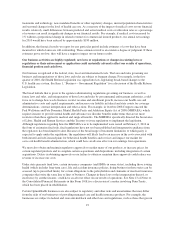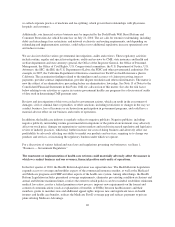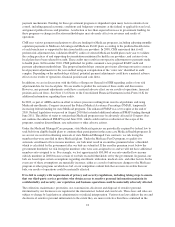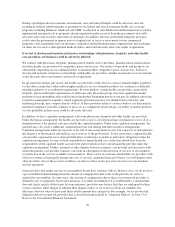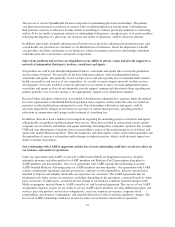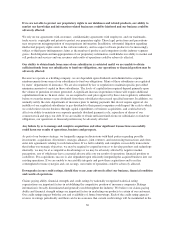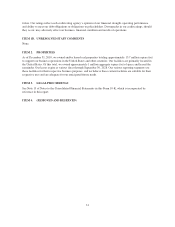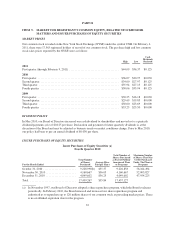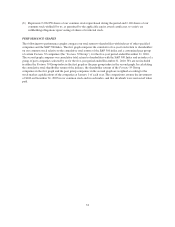United Healthcare 2010 Annual Report Download - page 25
Download and view the complete annual report
Please find page 25 of the 2010 United Healthcare annual report below. You can navigate through the pages in the report by either clicking on the pages listed below, or by using the keyword search tool below to find specific information within the annual report.payment mechanisms. Funding for these government programs is dependent upon many factors outside of our
control, including general economic conditions and budgetary constraints at the federal or applicable state level,
and general political issues and priorities. A reduction or less than expected increase in government funding for
these programs or change in allocation methodologies may adversely affect our revenues and results of
operations.
CMS uses various payment mechanisms to allocate funding for Medicare programs, including adjusting monthly
capitation payments to Medicare Advantage and Medicare Part D plans according to the predicted health status
of each beneficiary as supported by data from health care providers. In 2008, CMS announced that it will
perform risk adjustment data validation (RADV) audits of selected Medicare health plans each year to validate
the coding practices of and supporting documentation maintained by health care providers, and certain of our
local plans have been selected for audit. These audits may result in retrospective adjustments to payments made
to health plans. In December 2010, CMS published for public comment a new proposed RADV audit and
payment adjustment methodology. The proposed methodology contains provisions allowing retroactive contract
level payment adjustments for the year audited using an extrapolation of the “error rate” identified in audit
samples. Depending on the methodology utilized, potential payment adjustments could have a material adverse
effect on our results of operations, financial position and cash flows.
In addition, we are in discussions with the Office of Inspector General for HHS regarding audits of our risk
adjustment data for two local plans. We are unable to predict the outcome of these audits and discussions.
However, any payment adjustments could have a material adverse effect on our results of operations, financial
position and cash flows. See Note 13 of Notes to the Consolidated Financial Statements in this Form 10-K for
additional information regarding these audits.
In 2009, as part of ARRA and in an effort to relieve pressure resulting from state fiscal problems and rising
Medicaid enrollments, Congress increased the Federal Medical Assistance Percentage (FMAP), temporarily
increasing federal funding for state Medicaid programs. The enhanced FMAP was set to expire at the end of
2010. Federal legislation was passed in August 2010 that extended additional enhanced FMAP funding through
June 2011. The ability of states to sustain their Medicaid programs may be adversely affected if Congress does
not continue the enhanced FMAP beyond June 2011, which could result in a reduction of the scope of the
programs, member disenrollment, rate reductions or other adverse actions.
Under the Medicaid Managed Care program, state Medicaid agencies are periodically required by federal law to
seek bids from eligible health plans to continue their participation in the acute care Medicaid health programs. If
we are not successful in obtaining renewals of state Medicaid Managed Care contracts, we risk losing the
members that were enrolled in those Medicaid plans. Under the Medicare Part D program, to qualify for
automatic enrollment of low income members, our bids must result in an enrollee premium below a threshold,
which is calculated by the government after our bids are submitted. If the enrollee premium is not below the
government threshold, we risk losing the members who were auto-assigned to us and we will not have additional
members auto-assigned to us. For example, we lost approximately 650,000 of our auto-enrolled low-income
subsidy members in 2008 because certain of our bids exceeded thresholds set by the government. In general, our
bids are based upon certain assumptions regarding enrollment, utilization, medical costs, and other factors. In the
event any of these assumptions are materially incorrect, either as a result of unforeseen changes to the Medicare
program or other programs on which we bid, or our competitors submit bids that are more favorable than our
bids, our results of operations could be materially affected.
If we fail to comply with requirements of privacy and security regulations, including taking steps to ensure
that our third-party service providers who obtain access to sensitive personal information maintain its
confidentiality and security, our reputation and business operations could be materially adversely affected.
The collection, maintenance, protection, use, transmission, disclosure and disposal of sensitive personal
information by our businesses are regulated at the international, federal and state levels. These laws and rules are
subject to change by legislation or administrative or judicial interpretation. Various state laws address the use and
disclosure of sensitive personal information to the extent they are more restrictive than those contained in the
23








